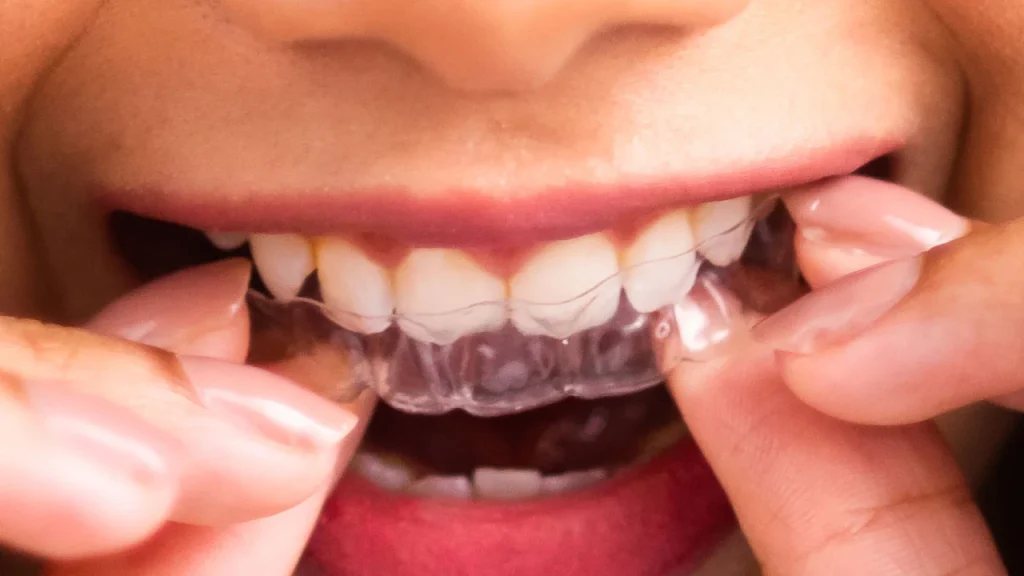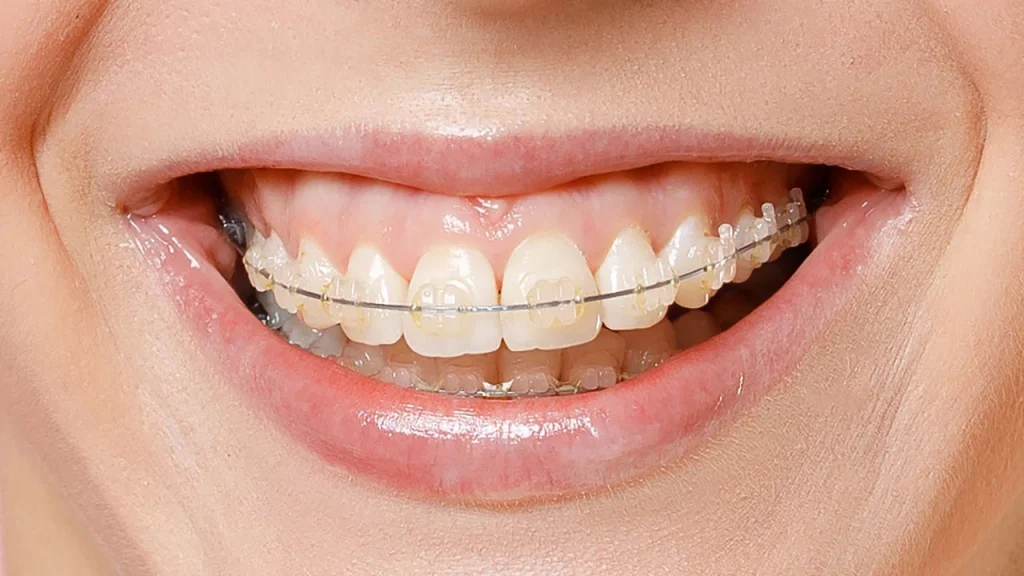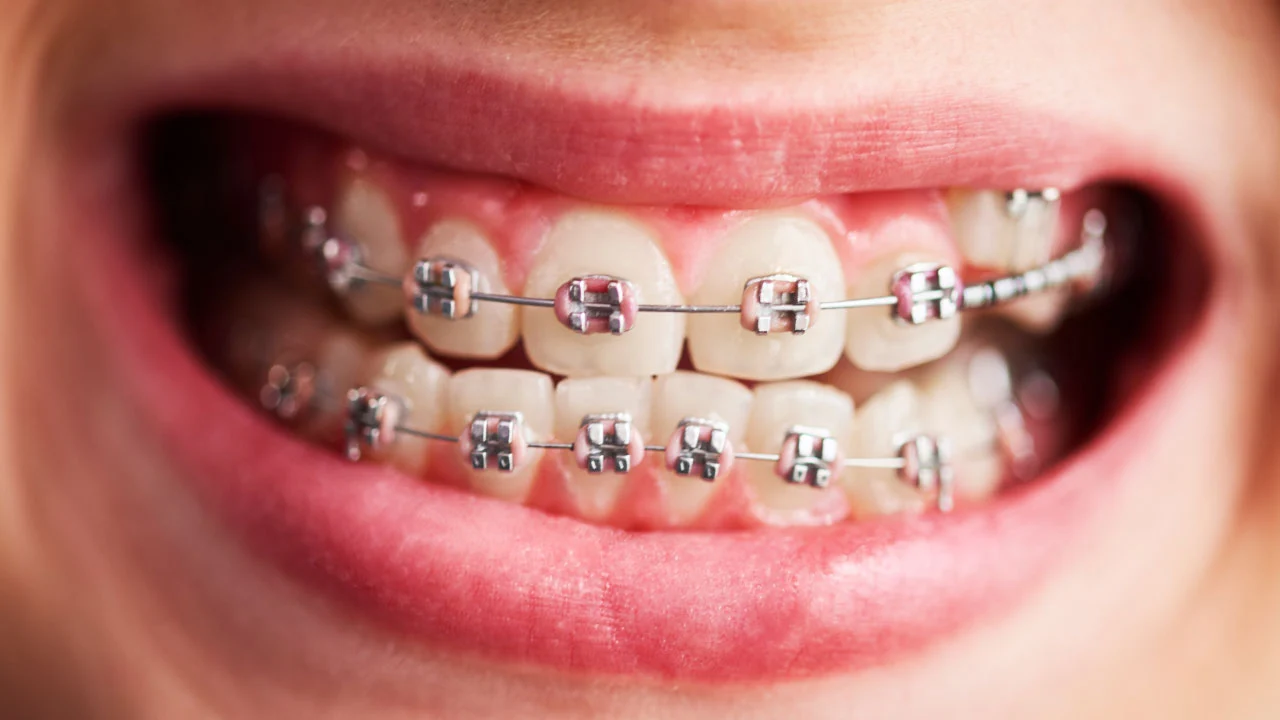In this article, we delve into the world of metal braces—how they work, their benefits, drawbacks, and how they compare to modern alternatives like clear aligners. Metal braces have been a staple in orthodontics for decades, offering effective teeth straightening solutions.
Whether you’re considering orthodontic treatment for yourself or exploring options for a loved one, understanding the fundamentals of metal braces is crucial. Join us as we uncover everything you need to know about metal braces.
What are metal braces?
Metal braces, or traditional braces as some call them, are orthodontic appliances used to straighten teeth. They consist of metal brackets bonded to each tooth’s front surface and connected by a metal wire.
Adjustments to the wire apply gentle pressure, gradually moving teeth into the desired position. Whether you’re dealing with a few crooked teeth or a more complex alignment issue, metal braces are a common choice for orthodontic treatment.
Where and why are metal braces used
Metal braces are versatile orthodontic appliances commonly used to correct dental issues such as crowded teeth, gaps, and misaligned bites. They are valued for their durability and affordability, making them a considerable option for patients seeking treatment. Metal braces provide precise control over tooth movement, ensuring reliable and consistent results.
They also offer customisation with options like colourful bands, catering to individual preferences.
Process of metal braces
Getting braces involves several key steps to ensure your treatment is effective and tailored to your needs. Here’s a concise breakdown of how metal braces work to straighten teeth, from the initial consultation to maintaining your new smile.
Initial Consultation
During your first visit, your orthodontist will check out your teeth, mouth, and jaw, often taking X-rays, photos, and impressions to get a full picture. They’ll chat with you about your dental issues, potential treatments, and what to expect, including how long it might take and how much it will cost.
Preparation
Based on the initial exam, a detailed treatment plan is made. This plan outlines the type of braces you’ll need, the timeline, and any preliminary treatments, like extractions or fillings.
Placement of braces
Your teeth will be thoroughly cleaned before the braces are applied. The orthodontist will put adhesive on the front surfaces of your teeth to hold the brackets.
After the brackets are in place, a wire is threaded through them to apply pressure and start moving your teeth. Small bands secure the wire to the brackets.
Adjustments and follow-up visits
You’ll need regular adjustments every 4-8 weeks. During these appointments, the orthodontist will tighten the wire and make necessary changes to ensure your teeth are moving correctly.
Maintaining oral hygiene
Good oral hygiene is key while wearing braces. Regular brushing and flossing help prevent cavities and gum disease. You’ll also need to avoid sticky or hard foods that could damage your braces.
Completion of treatment
Once your teeth have moved into their new positions, the braces are removed. Your teeth will be cleaned, and you’ll receive a retainer to keep them in place. Follow-up appointments will ensure your teeth stay aligned, and maintaining good oral hygiene remains important.
Pros and cons of metal braces
Now that we have understood the basics of metal braces, let’s dive deeper into their benefits and drawbacks. Below is a quick overview:
Pros | |
Effective for Complex Cases | Metal braces can correct severe misalignments and complex bite issues by applying precise and powerful forces over time |
Generally Lower Cost | They’re often more affordable than other orthodontic options, making them a budget-friendly choice for teeth straightening. |
Trusted and Proven Treatment | With decades of use, metal braces have a reliable track record of successfully straightening teeth for patients. |
Suitable for All Age Groups | They work well for both children and adults, offering a versatile solution for various dental alignment issues. |
Cons | |
Highly Visible | Metal braces are noticeable due to their metal brackets and wires, which can be a downside for those wanting a more discreet option. |
Discomfort and Mouth Sores | They can cause discomfort and irritation, especially after adjustments, leading to soreness or minor cuts inside the mouth. |
Dietary Restrictions | Patients must avoid sticky and hard foods that can damage the braces or cause discomfort, which can be inconvenient. |
Regular Adjustments Required | Frequent visits to the orthodontist for adjustments are necessary, which can be a hassle for those with busy schedules. |
Comparing metal braces with other braces methods
When choosing the right braces for your orthodontic treatment, it’s essential to weigh the options available. Metal braces are a popular choice, but how do they stack up against other alternatives? Let’s explore how metal braces compare with other braces methods.
Metal braces vs invisible braces
When it comes to straightening teeth, both metal braces and invisible braces offer effective solutions, each with distinct benefits. Metal braces are renowned for their durability and effectiveness in addressing complex orthodontic cases.
In contrast, invisible braces like Zenyum Invisible Braces have become popular for their discreet appearance and convenience, while still effectively correcting dental alignment issues.
Find out why invisible braces are increasingly favoured by many:
Features | Invisible Braces | Metal Braces |
Appearance | Clear, subtle look | Visible metal brackets and wires |
Comfort | Generally more comfortable | Brackets and wires may cause ulcers |
Removability | Easily removable for eating, brushing and flossing | Food may get stuck and extra care needs to be taken when brushing and flossing |
Dental visits | Generally fewer dental visits | Adjustments are required every 4 – 6 weeks at the dental clinic |
Zenyum Invisible Braces

Interested in an all-around solution? Zenyum Invisible Braces offer the best of both worlds: effective teeth straightening with unmatched convenience. These tailor-made aligners are practically invisible, ensuring a discreet teeth alignment process.
They’re designed to be removable for eating and cleaning, providing exceptional comfort and hygiene. With reduced dental appointments and adjustments, Zenyum Invisible Braces seamlessly integrate into your daily life, offering a reliable path to a confident smile.
Ceramic braces vs metal braces

Ceramic braces are a type of orthodontic appliance that uses tooth-coloured or clear ceramic brackets to straighten teeth. They function similarly to traditional metal braces but offer a more aesthetic alternative by blending in with the natural colour of teeth.
Here is a brief comparison between the two:
Features | Ceramic Braces | Metal Braces |
Appearance | Less noticeable due to tooth-coloured or clear brackets | Visible metal brackets and wires |
Material | Made from ceramic material, which is less conspicuous | Made from stainless steel |
Staining | More stain-resistant, but requires diligent oral hygiene | Does not stain, but can affect appearance due to visibility |
Cost | Generally more expensive due to materials and aesthetic appeal | Generally more cost-effective |
Durability | Sturdy, but may be more prone to breakage | Durable and can withstand more pressure |
If you’re interested to learn more about ceramic braces, head over to our blog where we dive into what you need to know about ceramic braces.
Cost of metal braces in Singapore
In Singapore, getting metal braces usually costs between $3,500 to $6,000. The total can vary depending on factors like how complicated your teeth are to straighten, where the dental clinic is located, how experienced the orthodontist is, and any extra treatments needed (like tooth removal).
It’s a good idea to chat with a trusted dental expert to get a precise estimate that fits your specific situation.
Orthodontic methods | Cost (SGD) |
Metal braces | Usually between $3,500 – $6,000* |
ZenyumClear™ | $2,690 |
ZenyumClear™ Plus | $4,090 |
ZenyumClear™ Extra | $4,590 |
Ceramic braces | Usually between $4,500 – $6,500* |
Lingual braces | Usually between $5,000 – $12,000* |
*The listed prices are meant to be taken as a guide at the time of publication. Prices may be subject to prevailing GST and service charge (if any).
Metal braces, a traditional choice for straighter teeth
Today, we’ve delved into metal braces, from how they straighten teeth to their benefits and drawbacks. We’ve compared them with both invisible braces and ceramic braces, and touched on the costs you might encounter in Singapore.
While metal braces are a reliable choice, modern options like Zenyum Invisible Braces offer an equally comprehensive, sleeker, and easier way to achieve your dream smile.
Ready to find out more?
Take a step towards a brighter smile with Zenyum’s modern solutions.





